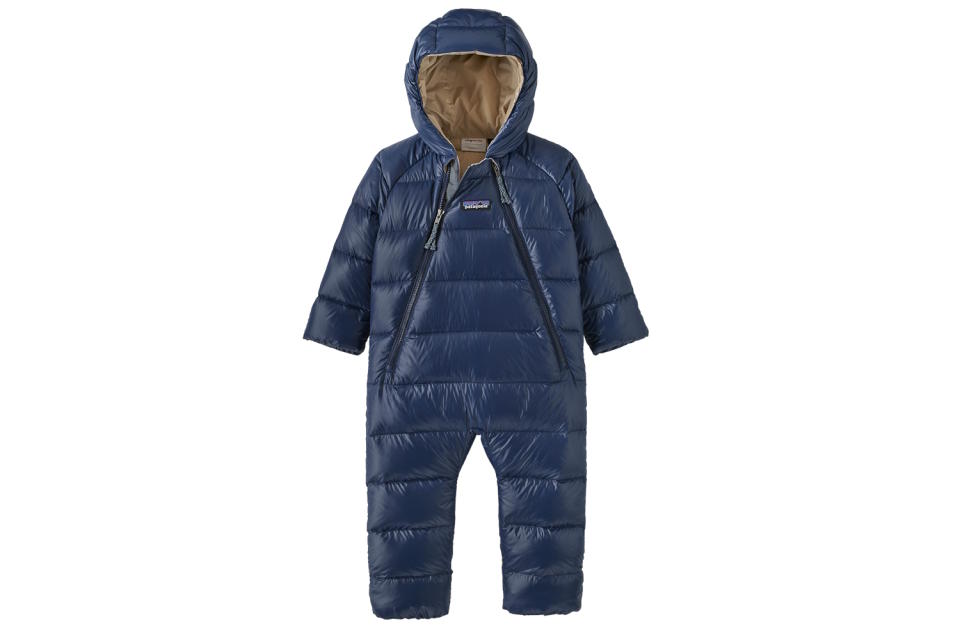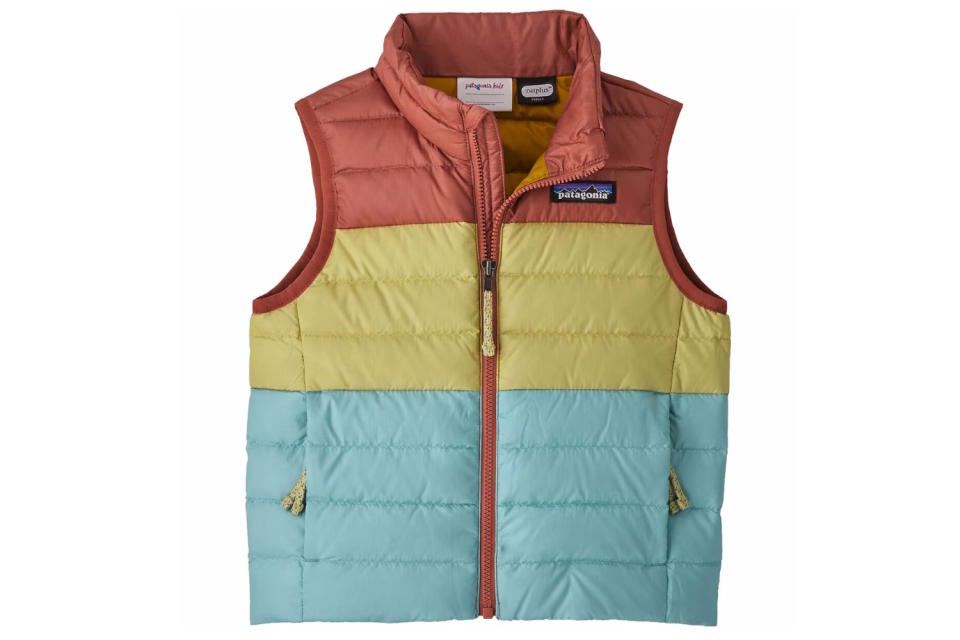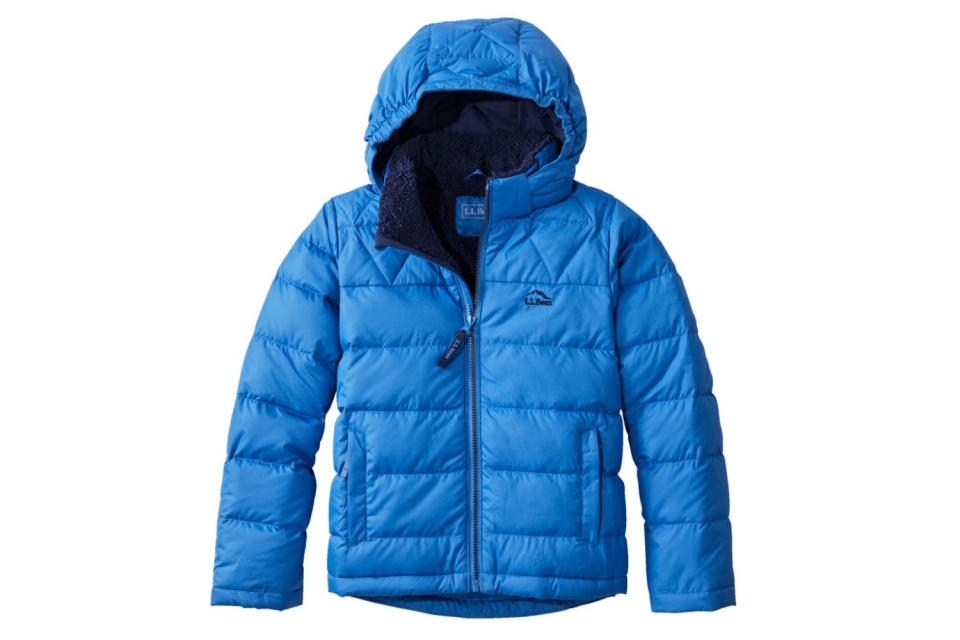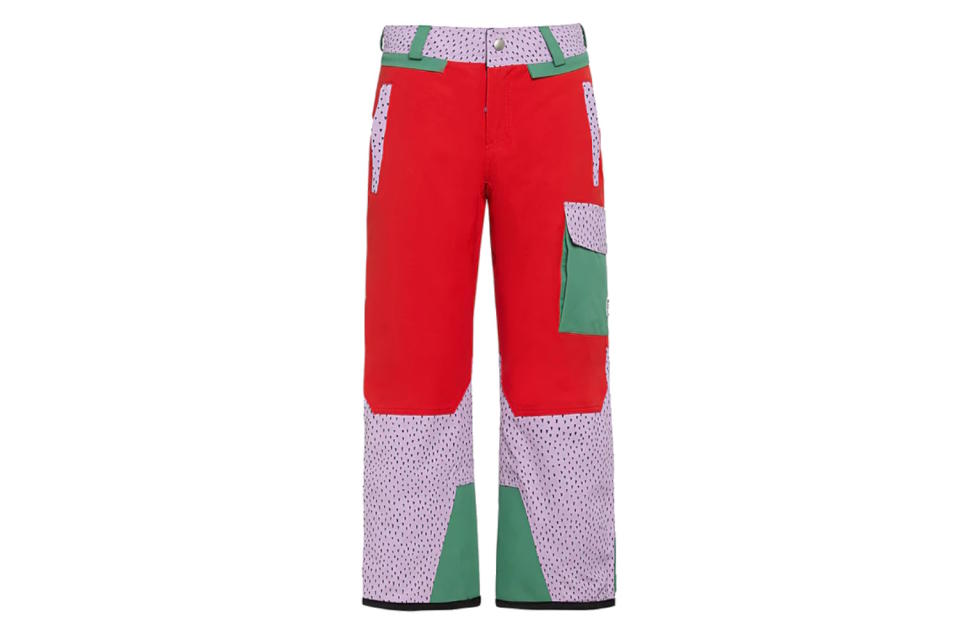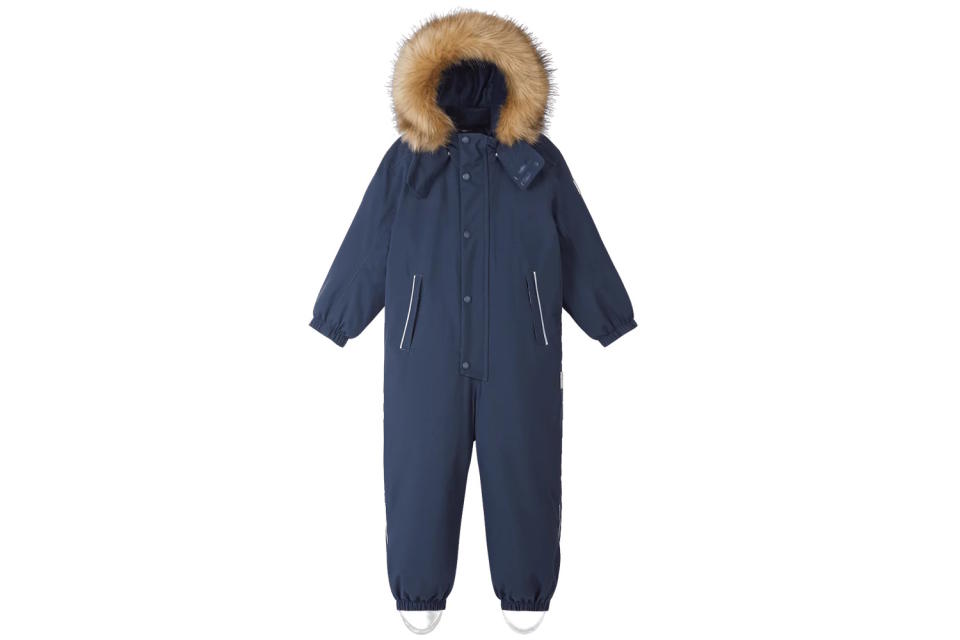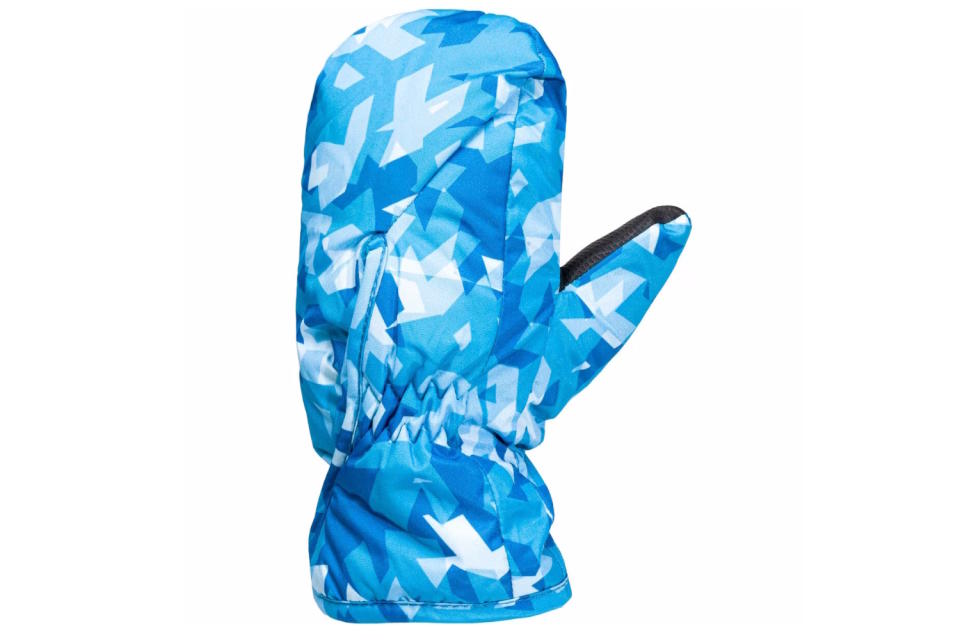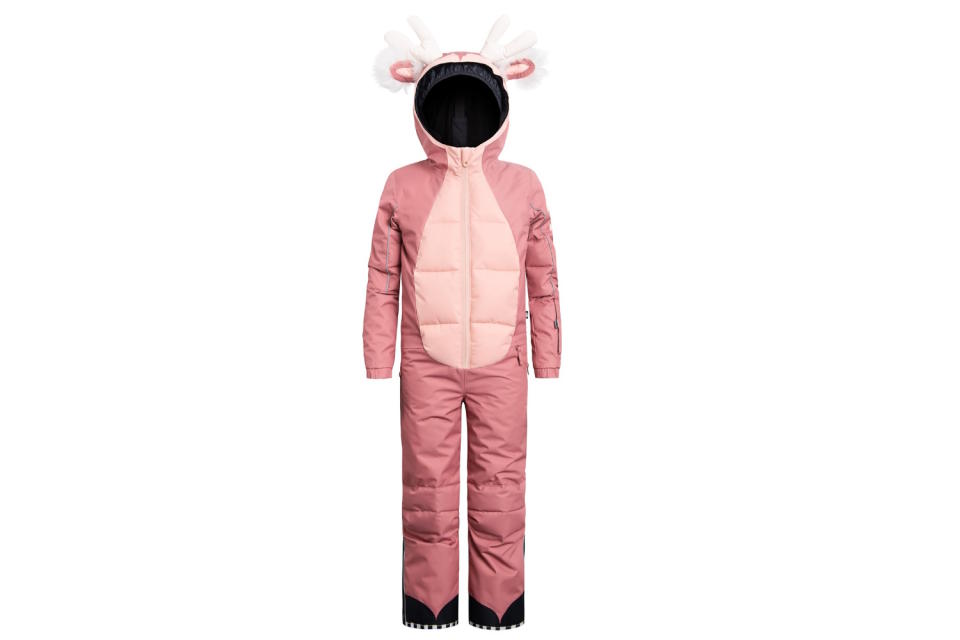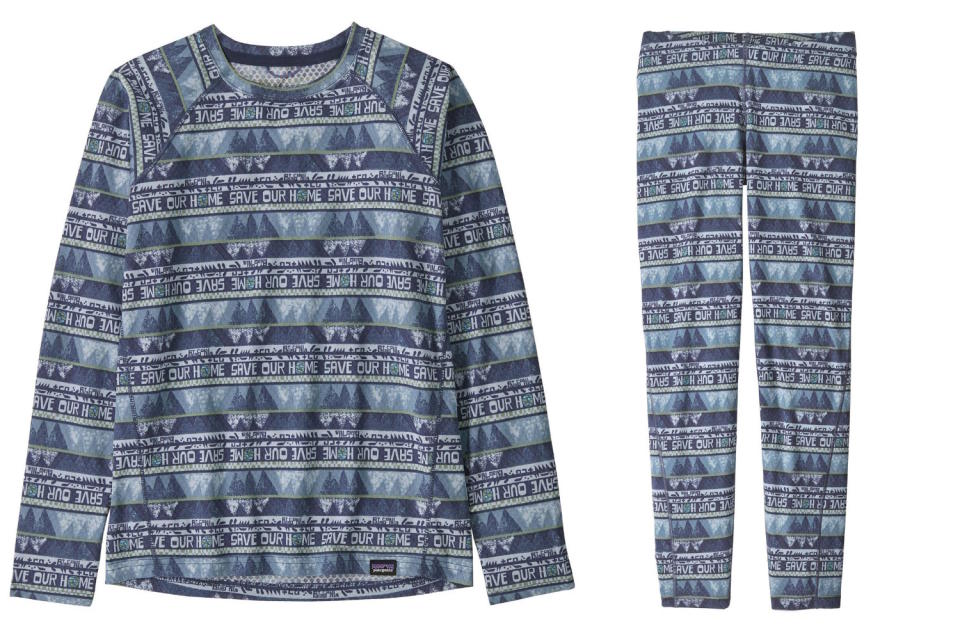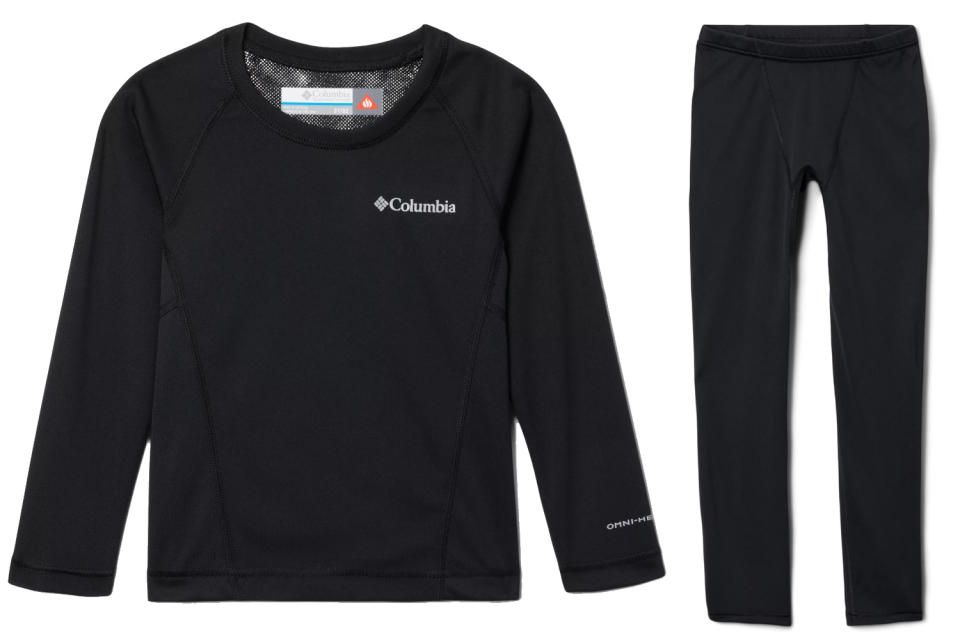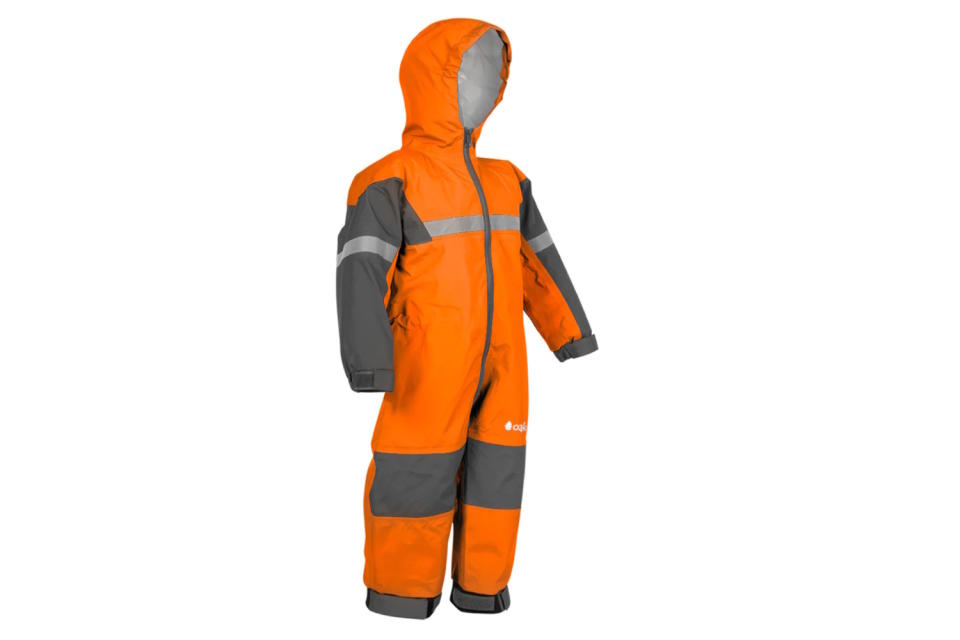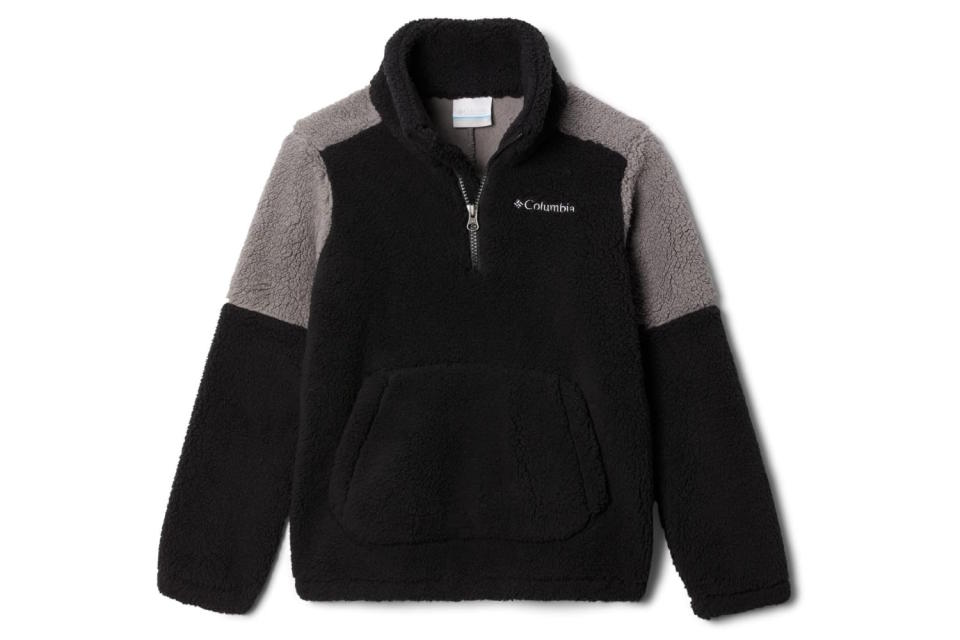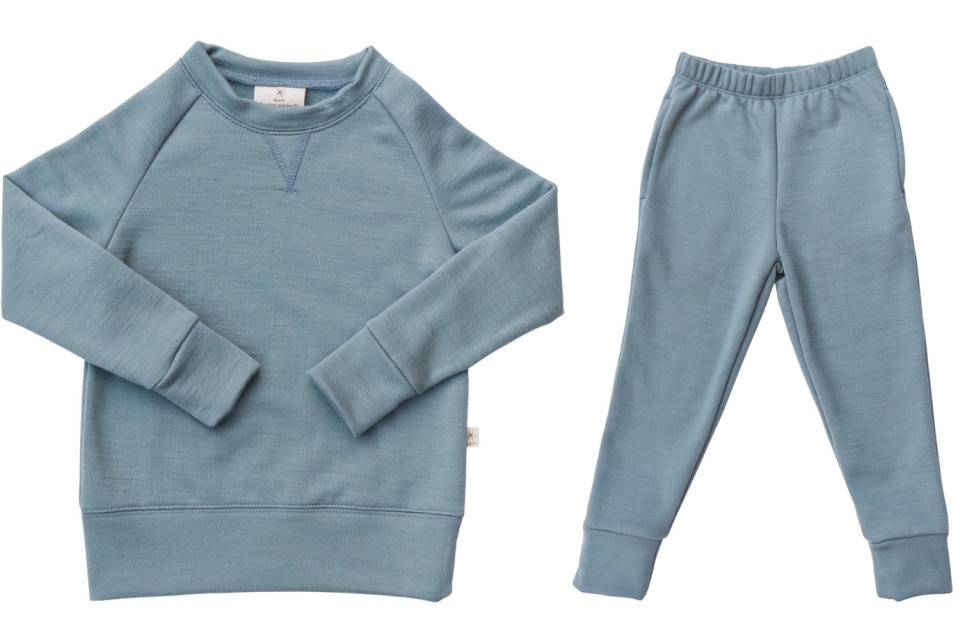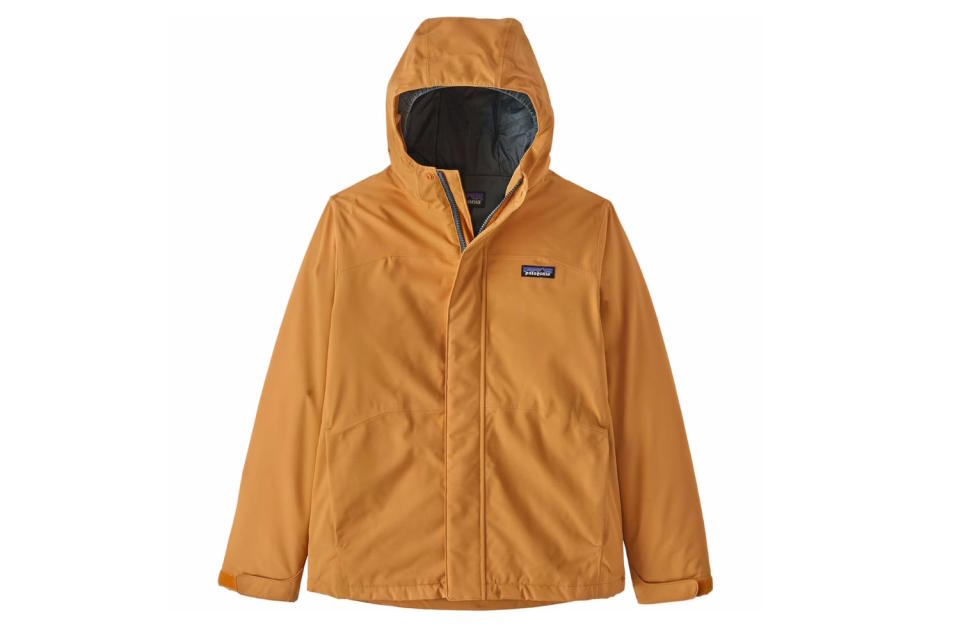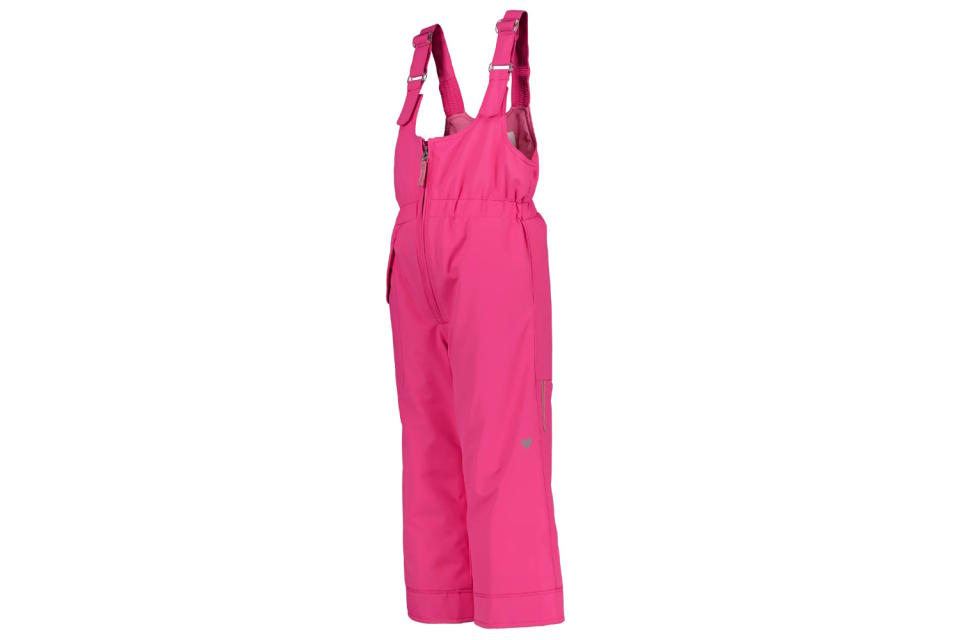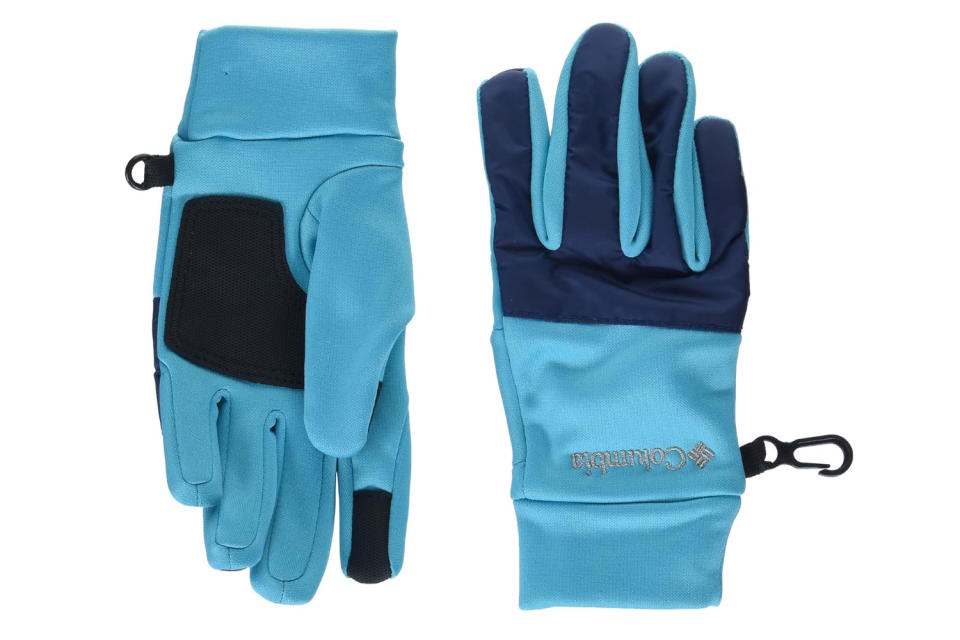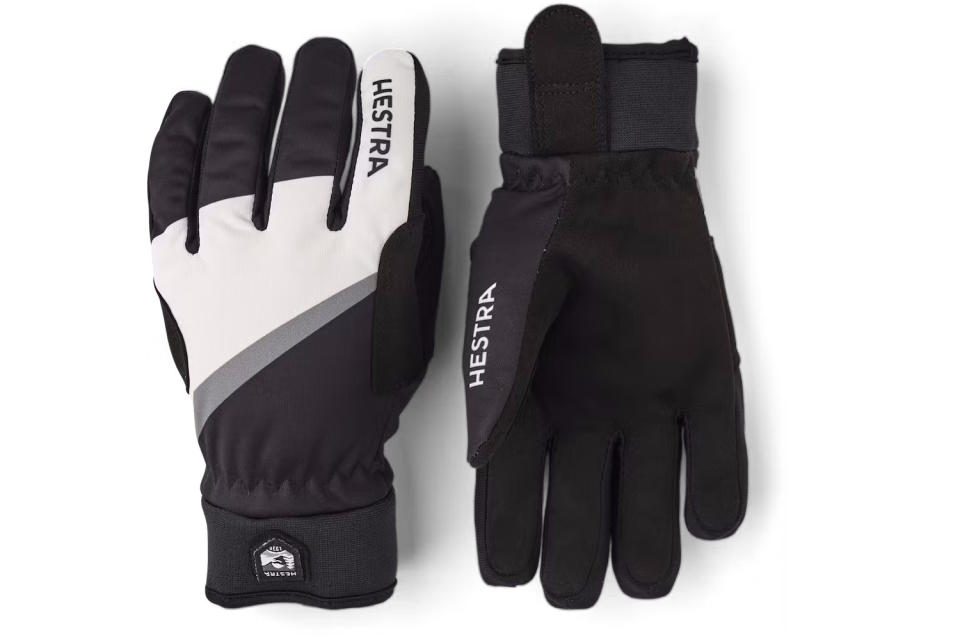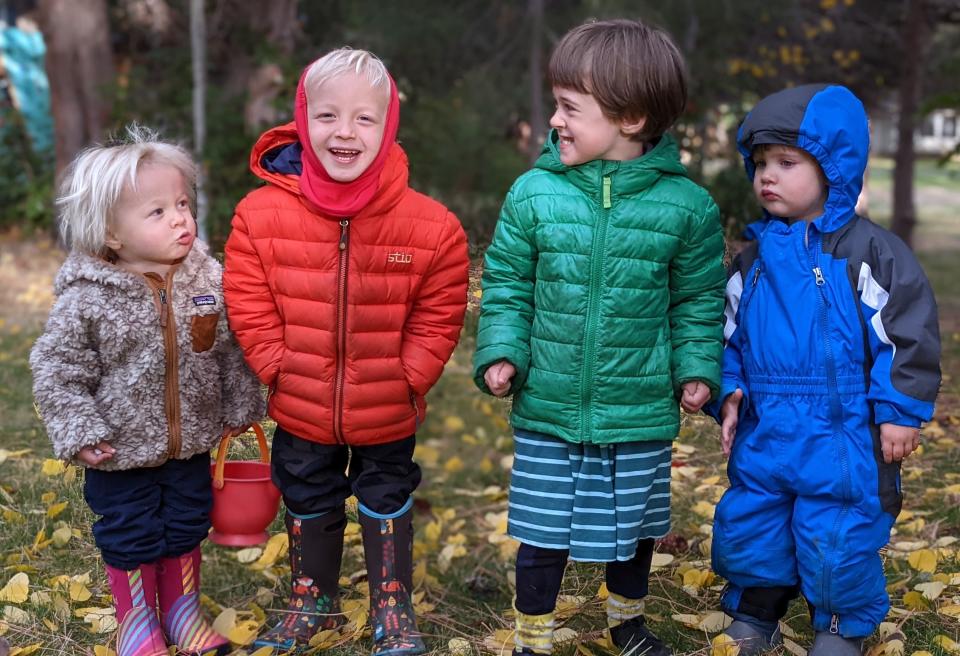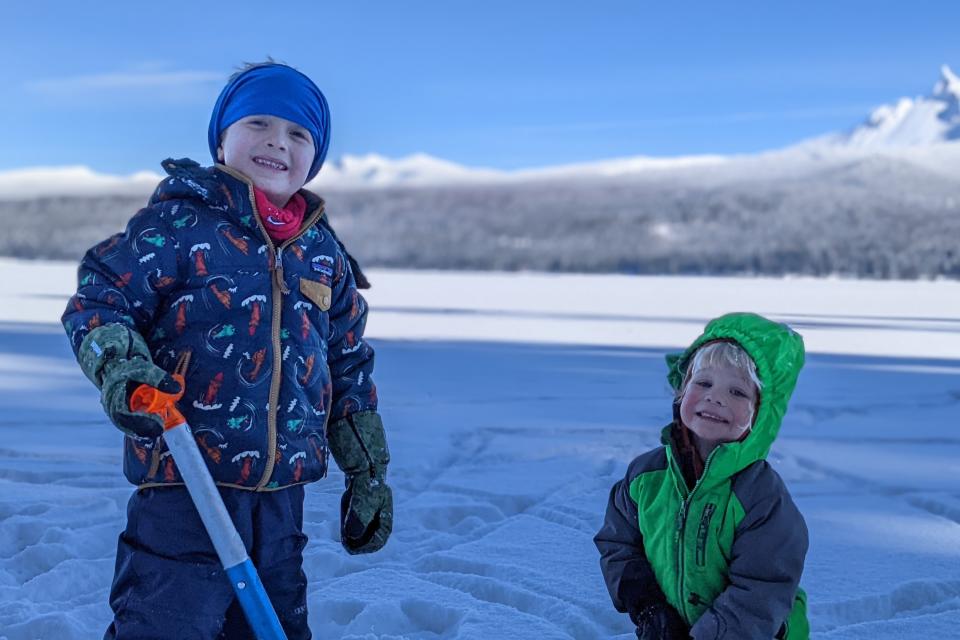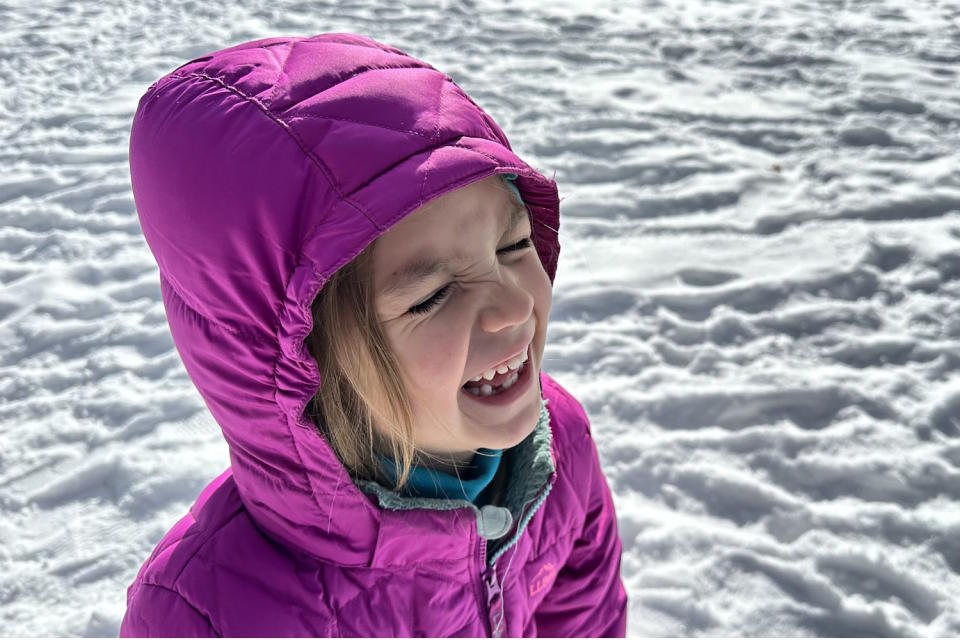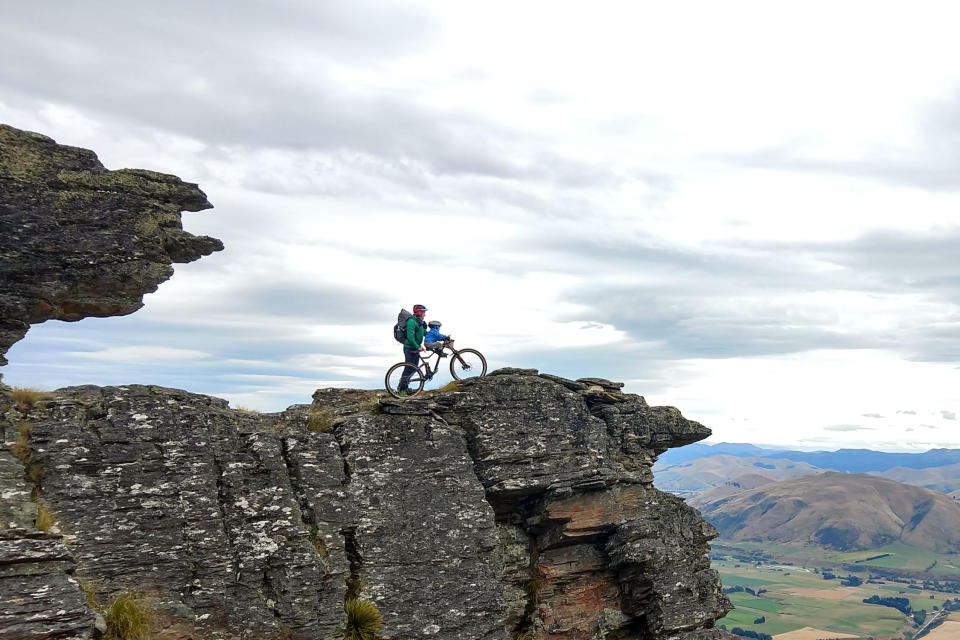The Best Kids’ Snow Gear of 2024
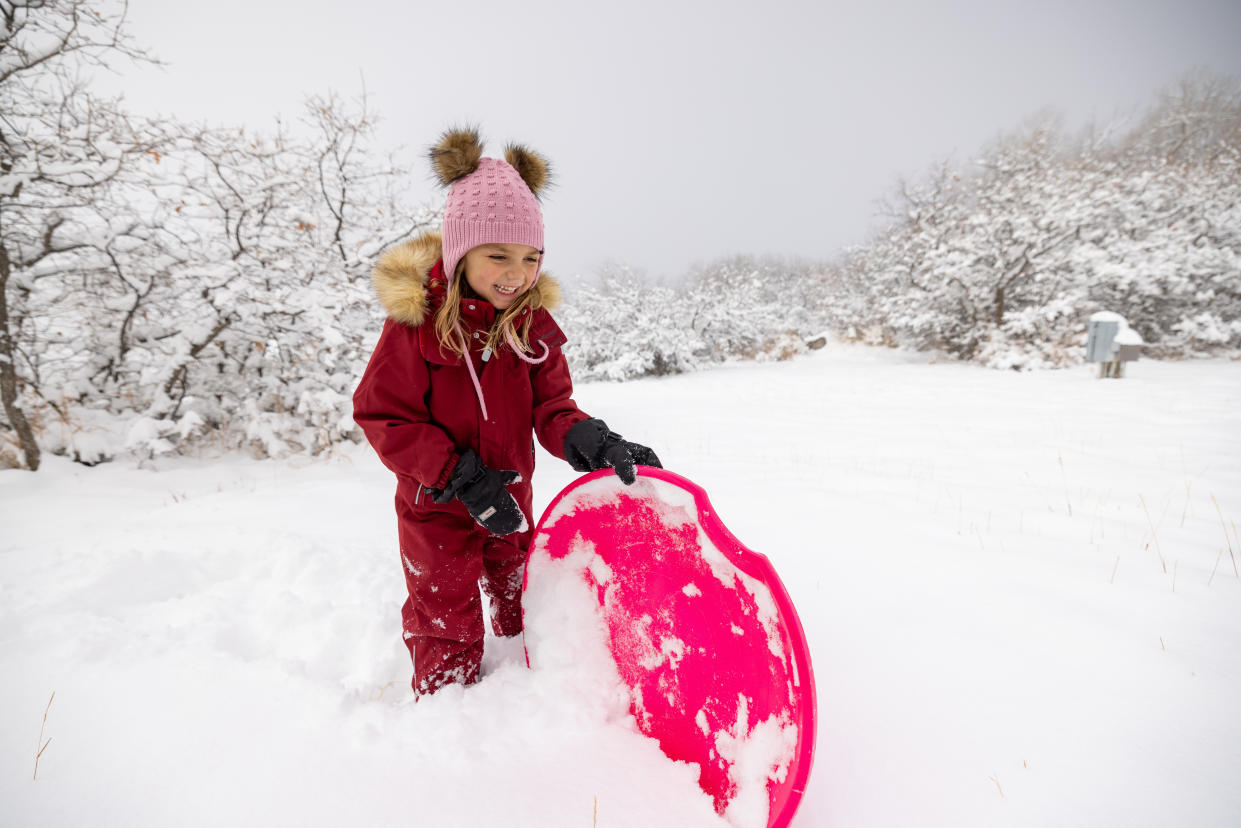
There is no better way to raise future adventurers than getting them outside when they’re little. It’s not always easy, but it is always worth it. We never regret a day spent outside with our children—but we will definitely take help when we can get it.
That’s why quality winter snow gear and apparel for kiddos matters so much. Not only is this gear the first line of defense protecting our children from the bitter cold, but also it enables parents to get outside more, too.
And now, kids’ snow gear is better than ever before. Instead of shrinking down adult ski jackets, outdoor brands are specifically designing gear that caters toward our kids’ movements.
End result: happy kids, happy parents, and more days outside.
If you’d like to learn what differentiates each product from another, be sure to check out the buyer’s guide, FAQ, and comparison chart at the end of this article. Otherwise, read our full gear guide below.
Editor’s note: We updated our Kids’ Snow Gear guide on February 13, 2024, to include more freshly tested products including the Reima Stavanger Snowsuit, Namuk Crusade Snow Pants Upcycled, and Weedo Ohdeer Deer Snowsuit.
The Best Kids’ Snow Gear of 2024
Best Base Layers: Iksplor Kid Iksplorer Set
Best Bunting Suit: Patagonia Bunting Sweater
Best Midlayer: Patagonia Baby Down Sweater Vest
Best Winter Jacket: L.L.Bean Kids’ Down Jacket
Best Snow Pants: Namuk Crusade Snow Pants Upcycled
Best Snowsuit: Reima Stavanger Snowsuit
Best Mittens: Gordini Easy-On Mittens
Best Base Layers for Kids
Iksplor Kid Iksplorer Set
Specs
Available sizes 2T-12 years old
Materials 100% merino wool
Waterproof No
Pros
Made in the USA
Machine washable
Merino naturally regulates body temperature
Cons
Wool always costs more than synthetic fibers
Our Oregon-based tester raves about these American-made wool base layers for kids, and it’s easy to see why. Not only is the Iksplor Kid Iksplorer Set ($109) made from 100% merino wool, but it’s also fully certified under the Responsible Wool Standard. This means that the wool comes from suppliers who are paying attention to land use and animal welfare requirements.
Beyond their environmental impact, the Iksplorer Set gets high marks for a universal fit. Iksplor designs the layers to be a bit long so kids can hopefully get a couple of seasons of use. And, one tester noted that the longer length gave her kiddo extra coverage along the hemline and wrists.
The merino of the Iksplor Kid Iksplorer Set is soft to the touch—no itchiness to irritate a fussy kid—and breathable enough that your children won’t overheat while tossing those snowballs.
Best Bunting Suit for Kids
Patagonia Infant High-Loft Down Sweater Bunting
Specs
Available sizes Newborn – 24 months
Materials Recycled polyester, recycled nylon, and recycled down insulation
Waterproof No
Pros
Made from recycled materials
Plenty of room to grow, no matter the size
Extreme warmth
Cons
Not truly waterproof
Sleep well at night knowing your babe is wrapped in environmentally friendly warmth. The Patagonia Infant High-Loft Down Sweater Bunting ($169) is made from exclusively recycled materials: recycled nylon from fishing nets pulled out of the ocean, recycled taffeta in the shell, and 100% recycled down insulation reclaimed from other projects. Bonus: Patagonia also uses a PFC-free Durable Water Repellent (DWR) coating so your kid isn’t wrapped in chemicals, too.
And, this piece performs well. Our testers loved the intuitive entry and exit zipper placement that makes it easy to get onto wriggling babies.
Warmth is also top-notch, as one Colorado tester learned after taking her five-month-old on a backcountry hut trip near Crested Butte. Caveat: While water resistant, this bunting is not waterproof.
Fit note: The Patagonia Infant High-Loft Down Sweater Bunting runs large. One tester’s daughter wore her six-month bunting until she was nearly 15 months old.
Best Midlayers for Kids
Patagonia Baby Down Sweater Vest
Specs
Available sizes 3 mos.- 5T
Materials Recycled nylon, recycled taffeta, and recycled down
Waterproof No
Pros
Adds mobility compared to a puffy
700-fill power makes it super packable for parents
Elasticized arm cuffs don’t pinch skin
Cons
Fairly pricey for a vest
Kids wiggle and move a lot. They also whine—especially when something is uncomfortable. For kids who love to fuss over the bulk of their layers, consider the Patagonia Baby Down Sweater Vest ($99). It has all the good stuff to keep your kiddo warm including 700-fill power of 100% recycled down.
This layer is ultra-packable too, with our tester noting that she shoves her child’s vest in the exterior water bottle pocket of her backpack.
As with the Patagonia bunting, the vest runs big. One preschooler wore her size 2T until she was nearly five years old. But even then, the spandex elasticized armholes weren’t constricting or cutting in her armpits.
In more good feedback, the Patagonia Baby Down Sweater Vest is lightweight and easily fits under jackets.
$99 at Patagonia$50 at Backcountry
Best Winter Jackets for Kids
L.L.Bean Kids’ Down Jacket
Specs
Available sizes Little kids 4 – Big kids 18
Materials Ripstop nylon, polyester fleece, and down insulation
Waterproof No
Pros
Great mobility for kids to play and run
Plenty of warmth for most winter adventures
Wide range of sizes
Cons
Puffy jackets aren’t very durable
When the mercury drops, put your kiddo in the L.L.Bean Kids’ Down Jacket ($109). Reported to be one of the brand’s warmest options for littles, one lead tester wore it to forest school for a winter in Colorado and it quickly became her favorite jacket to bring.
The secret: ultra mobility and supreme coziness. Credit the 650-fill DownTek down and an uber-soft fleece interior for making it a favorite among kids.
Two zippered hand pockets are lined with a light fleece and have plenty of room for small toys, snacks, or the occasional pinecone. The insulated hood on the L.L.Bean Kids’ Down Jacket is a game changer on blustery days, but it’s removable for when the sun peaks out again.
Best Snow Pants for Kids
Namuk Crusade Snow Pants Upcycled
Specs
Available sizes 2T – 13 years old
Materials Upcycled polyester; recycled synthetic insulation
Waterproof Yes
Pros
Biodegradable insulation
Loose, freerider fit that pleases most kids
Machine washable
Cons
Pricey for just snow pants
It’s the perfect trifecta: style, functionality, and environmental responsibility. The Namuk Crusade Snow Pants Upcycled ($149) come from a Swiss brand that only makes kids’ gear — nothing for adults. That means they have the details dialed on kids’ gear and apparel since it’s their only focus.
In the Crusade snow pants, that means plenty of pockets for snacks and the occasional toy, as well as brightly-colored patterns that stand out against other snow pants. They’re fully waterproof too, and one tester wore them skiing all winter without any saturation issues.
But the highlight of the Crusade Upcycled snow pants is their dedication to sustainability. Each pair of Upcycled snow pants uses leftover fabric remnants from previous years, so no two pants are the same. (There’s also a non-upcycled Crusade snow pant made with 100% polyester, so don’t be confused.)
And the warmth of the Namuk Crusade Snow Pants Upcycled comes from PrimaLoft Bio, a 100% recycled synthetic insulation that also biodegrades in landfills. Of course, all that goodness comes with a tradeoff: They aren’t cheap.
Best Snowsuit for Kids
Reima Stavanger Snowsuit
Specs
Available sizes 2T – 10 years old
Materials Regular and recycled polyamide, regular and recycled polyester, Fellex insulation
Waterproof Yes
Pros
Unparallelled warmth and waterproofing
Unique, kid-specific features
Plenty of fun colors for kids
Cons
Pricey
Kids have complained that it’s too warm
We’re convinced: There is no burlier snowsuit than the Reima Stavanger Snowsuit ($195). Our GearJunkie testers often ski tour while towing their daughter in a Thule Chariot in the mountains outside of Aspen, Colorado, and the Stavanger was always the last line of defense against extreme cold temperatures thanks to copious amounts of recycled synthetic insulation.
When combined with a sturdy synthetic outer shell and waterproof-sealed seams, it’s nearly impossible for chilly weather to find its way inside.
Reima includes plenty of kid-specific features that make the Stavanger a crowd favorite. Not only do they pack in extra insulation on the butt to offset kids sitting in the snow, but the snowsuit also includes silicone foot loops that hook around snow boots to prevent pant legs from riding up. At forest school, one tester walked through an ankle-deep river, and the Stavanger still never wet out.
The fit runs a bit large but go with the standard sizing — your kiddo will just wear it for a few years. Bonus: The Reima Stavanger Snowsuit has a removable hood lined with faux fur that helps keep snowflakes off rosy cheeks.
Best Mittens for Kids
Gordini Easy-On Mittens
Specs
Available sizes XXS-XL
Materials Ripstop nylon, Megaloft synthetic insulation, Dri-Max waterproof insert
Waterproof Yes
Pros
Easy on-off for kids
Grippy palm that makes mittens less cumbersome
Incredibly warm
Cons
Some testers had a hard time keeping them on
When it comes to mittens, Vermont-based Gordini knows what it’s doing. The brand makes amazing gloves and mittens for all members of the family, but we were beyond impressed with the Gordini Easy-On Mittens ($30) for toddlers.
The features are everything you want in a mitten. The outer material is grippy enough for kids to hold onto things, and the dreaded thumbhole is super easy for them to put their own thumb into, thanks to the long zipper on the side of the mitten. Our 5-year-old tester had zero issues pulling these on by herself—a modern miracle.
The side zipper serves two functions since it also makes it easy to pull the gauntlet wrist over any jacket. Both our 5-year-old and 2-year-old testers agree — the Gordini Easy-On Mittens are the warmest and most playful mittens we’ve tested.
$30 at Backcountrycheck price at gordini
Best of the Rest
WeeDo Ohdeer Deer Snowsuit
Specs
Available sizes XS- L
Materials Polyester and recycled polyester
Waterproof Yes
Pros
Cutest design on the ski hill
Internal suspenders are a great feature for snowsuits
Toilet zipper for bathroom breaks
Cons
Very expensive
If your kid wants to make a statement on the ski hill, there is no better way to do so than the WeeDo Ohdeer Deer Snowsuit ($282). WeeDo managed to create a series of fun-loving snowsuits themed after a variety of creatures such as a unicorn, dinosaur, or even a raccoon.
But, they function even better than they look thanks to unique features designed for kids. Our favorite: the full-waist zipper that splits the snowsuit in half to make bathroom breaks easier.
We also love the internal suspenders on the WeeDo Ohdeer Deer Snowsuit that allowed our 5-year-old tester to walk around the ski lodge without dragging the top of her snowsuit behind. And, did you note those cute lil’ antlers?
Read the full GearJunkie review of the WeeDo Ohdeer Deer Snowsuit.
$210 at evo$260 at Backcountry
Patagonia Midweight Capilene Crew & Bottoms
Specs
Available sizes XS-XXL
Materials Recycled polyester
Waterproof No
Pros
More affordable than wool
Recycled polyester is less reliant on fossil fuels than virgin polyester
Smooth surface is great for layering
Cons
Not a ton of fun colors for kids
If allergies or pricing keep you away from wool, then Capilene is another great option. We love the Patagonia Midweight Kids’ Capilene Crew and Bottoms ($35-39). They’re made from 100% recycled polyester with an exceedingly soft surface that kids love.
When combined with the slim fit, we had zero complaints from one preschool tester as we layered her snowsuit over top of them.
Polyester layers typically hold onto odors more than wool, but Patagonia uses an antimicrobial coating that keeps smells at bay. One tester wore the Patagonia Midweight Kids’ Capilene Crew and Bottoms through four days of skiing and her parents barely noticed a smell.
$39 at Patagonia – Shirt$27 at Patagonia – Pants
Columbia Kids’ Omni-Heat Midweight Baselayer Crew & Bottom
Specs
Available sizes XXS-XL
Materials Polyester
Waterproof No
Pros
Super warm during high-output activities
Affordable
Cons
Definitely stink after a few use
The Columbia Kids’ Omni-Heat Midweight Baselayer Crew ($30) and Bottom ($20) check a lot of boxes for outdoor and active kiddos. These 100% polyester baselayers have Columbia’s OmniHeat thermal reflective technology lining the inside, designed to bounce your kid’s body heat back at him. And, it works.
Our field testers pulled on these layers for 3 months and found themselves happy and dripping sweat after an intense snowball fight.
While the Columbia Kids’ Omni-Heat Midweight Baselayer Crew and Bottom do wick moisture well, we still noticed a bit of body odor after a couple of days. Bonus: The price tag is also nice on the wallet.
$20 at Amazon – Pantscheck crew price at columbia
Oaki Rain/Trail Suit
Specs
Available sizes 12 month – 15 years old
Materials Nylon and polyester
Waterproof Yes
Pros
Waterproof one-piece keeps everything out
Wide range of sizes to fit a swath of kids
Cons
Requires hand washing and air drying, which can be time consuming
Forest school is usually where kids’ snow gear goes to die. But, the Oaki Rain/Trail Suit ($79) proved otherwise after one GearJunkie tester sent her son out for 5 hours per day all winter long—and he always came back dry, warm, and delightfully clean.
The secret is the fully waterproof, one-piece design that is more impenetrable than a fortress thanks to a nylon and polyester outer with a polyurethane membrane.
In testing the Oaki Rain/Trail Suit, we also loved the off-center zipper that goes all the way past the crotch, making nature pees quick and easy.
Columbia Rugged Ridge Half-Zip Sherpa Pullover
Specs
Available sizes XXS-XL
Materials Polyester
Waterproof No
Pros
Extra cozy while wearing
Large kangaroo pocket to keep hands warm
Cons
Some testers say the fit runs small
Cozy is king when it comes to kids. Thankfully, the Columbia Rugged Ridge III Half Zip Sherpa Pullover ($60) is about as comfy as a jacket can be with plenty of plush fleece to heat those chilly days.
A large kangaroo pocket in front has plenty of space for little hands (and maybe a toy) and the moderate hemline ensures plenty of coverage on the backside.
One GearJunkie tester says that the Columbia Rugged Ridge III Half Zip Sherpa Pullover is her kiddo’s favorite to toss under a waterproof shell for ultra-rainy days in the Pacific Northwest.
$40 at Backcountry$41 at Amazon
Chasing Windmills Merino Sweatshirt & Fleece Sweatpants
Specs
Available sizes 2-14
Materials Merino wool
Waterprooof No
Pros
Versatile enough to be outdoor midlayers or indoor jammies
Soft fleece interior is ultra cozy
Cons
Pricey for a full set
The Chasing Windmills Merino Fleece Sweatshirt and Sweatpants ($59) are envied by parents but built for kids.
Both layers are made with 100% New Zealand and Australian merino wool, so they dry quickly and help regulate body temperature. But the brushed fleece interior is beyond cozy, making this kit a perennial favorite for one 4-year-old who wears his to forest school during the day and on the couch at home at night.
Like traditional sweatpants, the fit is looser on the Chasing Windmills Merino Fleece Sweatshirt and Sweatpants. These are meant to be worn as midlayers.
check Shirt price at chasing windmillscheck Pants price at chasing windmills
Patagonia Everyday Ready Jacket
Specs
Available sizes XS-XXL
Materials Recycled polyester and recycled polyester taffeta
Waterproof Yes
Pros
Completely weatherproof
Fully recycled materials throughout
Cons
Some testers found the sizing to run small
Slim and trim. That’s the idea behind the Patagonia Everyday Ready Jacket ($159), a fully waterproof and insulated jacket designed to go anywhere with kids.
Patagonia uses its proprietary waterproof-breathable membrane and combines it with a DWR finish to keep unwanted moisture at bay. While there are 100 grams of recycled polyester insulation, the jacket isn’t bulky and it layers well.
Our 5-year-old tester used his Patagonia Everyday Ready Jacket on the bunny hill for ski season and was all smiles.
$79 at Patagonia$80 at Backcountry
Patagonia Baby Reversible Tribbles Hoody
Specs
Available sizes 3 mos. – 5T
Materials Recycled polyester and recycled polyester taffeta
Waterproof Yes
Pros
Reversible so you get two styles
All recycled materials
Cons
Some kiddos claim it’s “too warm” for moderate temperatures
Parents always love a good deal, and this one is a twofer. The Patagonia Baby Reversible Tribbles Hoody ($109) is not only fully reversible but it’s also made out of 100% recycled fleece on one side and 100% recycled polyester on the other.
Our testers loved this jacket for its big, cozy hood that comes with two snap buttons around the chin.
While in forest school, the Patagonia Baby Reversible Tribbles Hoody kept our 4-year-old tester plenty warm and dry. That said, he did refuse to put it on indoors because it’s “Too hot!” Fortunately, that’s exactly what we’d like to hear.
$109 at Patagonia$65 at Backcountry
Columbia Powder Turner Suspender Pants
Specs
Available sizes XXS – XL
Materials Polyester
Waterproof Yes
Pros
Adjustable suspenders work for most kids
Two types of insulation make these pants extra cozy
Omni-Heat Infinity liner helps to reflect and retain body heat
Cons
Can run long on some children
If you want your kiddo to keep her snow pants up but she hates bibs, reach for the Columbia Powder Turner Suspender Ski Pants ($90).
Built like snow pants but with the added nicety of adjustable elastic suspenders, the Powder Turners use synthetic insulation and thermal reflectivity to keep kiddos warm in the snow.
For longevity, the Columbia Powder Turner Suspender Ski Pants also come with a great feature called Outgrown. When they become too small, undo the bottom stitching to make room for another inch of length.
Obermeyer Snoverall Bib
Specs
Available sizes 1-8
Materials Polyester
Waterproof Yes
Pros
Quick-release shoulder straps
Plenty of color options for kiddos
Cons
Younger children may struggle with the design while using the bathroom
When your 2-year-old wakes up and immediately asks to put on his snow pants and go outside, you know you’re doing something right. These Obermeyer Snoverall Bibs ($100) are a true bib design with material covering the lower stomach.
The straps are adjustable and come with a quick-release feature, which makes them a lot easier to remove. But, one tester still struggled to get them off in time for the bathroom.
The Obermeyer Snoverall Bibs also feature an I-Grow system; snip a few threads and add up to two inches of length.
$49 at Backcountrycheck price at obermeyer
Columbia Kids’ Cloudcap Fleece Gloves
Specs
Available sizes XS-XL
Materials Polyester and elastane
Waterproof No
Pros
Affordable
Versatile enough for tons of activities
Cons
Not waterproof
The Columbia Kids’ Cloudcap Fleece Gloves ($25) fit a sweet spot: use them as liners or wear them solo when just a touch of warmth is needed.
Their cozy fleece is bolstered by Columbia’s hallmark thermal reflectivity on the interior, making one toasty pair of gloves. Thanks to a synthetic grip palm, kids can easily hang onto monkey bars or sleds.
While they aren’t great for true snow activities — because they aren’t waterproof—the Columbia Kids’ Cloudcap Fleece Gloves are a versatile pick anytime your kiddo needs dexterity and a bit of warmth.
Hestra Junior Tracker Gloves
Specs
Sizes 3-7
Materials Polyester and Primaloft insulation
Waterproof No
Pros
Great dexterity-to-warmth ratio
Very breathable
Cons
Not waterproof or warm enough for sedentary activities
Sweden-based Hestra has been making gloves and mittens since 1936, and the Hestra Junior Tracker ($50) gloves are one of our favorites for high-octane sports like cross-country skiing.
Durable stretch polyester on the palm made it easy for our tester to hang onto his poles, and the three-layer polyester shell offers plenty of breathability.
Still, the Hestra Junior Tracker is plenty warm thanks to the PrimaLoft Gold insulation.
$50 at Amazoncheck price at hestragloves
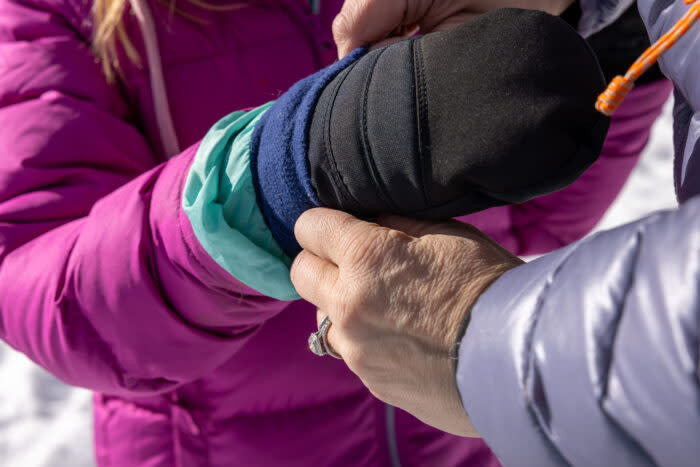
Kids’ Snow Gear Comparison Chart
Scroll right to view all of the columns: Price, Sizes, Materials, Waterproof.
Kids Gear | Price | Sizes | Materials | Waterproof |
|---|---|---|---|---|
$109 | 2T-12 years old | 100% merino wool | No | |
$169 | Newborn – 24 months | Recycled polyester, recycled nylon, and recycled down insulation | No | |
$99 | 3 mos.- 5T | Recycled nylon, recycled taffeta, and recycled down | No | |
$109 | Little Kids 4 – Big Kids 18 | Ripstop nylon, polyester fleece, and down insulation | No | |
$149 | 2T – 13 years old | Upcycled polyester; recycled synthetic insulation | Yes | |
$195 | 2T – 10 years old | Regular and recycled polyamide, regular and recycled polyester, Fellex insulation | Yes | |
$30 | XXS-XL | Ripstop nylon, Megaloft synthetic insulation, Dri-Max waterproof insert | Yes | |
$282 | XS- L | Polyester and recycled polyester | Yes | |
$35-39 | XS-XXL | Recycled polyester | No | |
$30-20 | XXS-XL | Polyester | No | |
$79 | 12 mos – 15 years old | Nylon and polyester | Yes | |
$60 | XXS-XL | Polyester | No | |
$59 | 2-14 | Merino wool | No | |
$159 | XS-XXL | Recycled polyester and recycled polyester taffeta | Yes | |
$109 | 3 mos. – 5T | Recycled polyester and recycled polyester taffeta | Yes | |
$90 | XXS – XL | Polyester | Yes | |
$100 | 1-8 | Polyester | Yes | |
$25 | XS-XL | Polyester and elastane | No | |
$50 | 3-7 | Polyester and Primaloft insulation | Yes |

How We Tested Kids’ Snow Gear
In addition to extensive research and knowledge of the category, we loaded our own children up with various apparel items last winter. They wore this gear downhill skiing, during family adventure trips, and every day to forest school, a type of outdoor preschool where the kiddos spend all day outside—no matter the weather. This meant the kids’ snow ski clothes were put through the wringer while walking through streams, hiking winter trails, cruising the local Nordic skiing loop, and riding bikes down snowy trails.
Based in Carbondale, Colorado, Heather Balogh Rochfort is an avid outdoorist with decades of experience in mountain snowsports like backcountry skiing, downhill skiing, uphilling, and cross-country skiing. She is also a mom to a vivacious kindergartener who logged more than 50 days at the local ski hill during the 2022-23 ski year. Her daughter is also learning how to cross-country ski and enjoys sledding after school, making her a prime tester for any and all kids’ gear and apparel. Contributor Chelsey Magness was also a lead tester with her family in the Pacific Northwest.
For this guide, we first looked at the essential items needed to safely get children outside in the snow: base layers, midlayers, jackets, snow pants, snowsuits, and gloves. From there, we looked at the overall quality of the item, durability, affordability, fit, and sustainability in regard to renewable fibers. We also considered kid-specific factors like ease of use and functionality since kids prioritize different components than adults do. We tried to look at each item from an adult perspective to evaluate everyday features like washability or easy-to-use buttons.
Finally, we considered style. While toddlers don’t really care about what they’re wearing, older kids definitely have opinions. It’s important for children to like their snow gear, so we took style and trends into consideration.
Buyer’s Guide: How to Choose the Best Kids’ Snow Gear
Choosing kids’ ski clothing is daunting because you’re looking at a number of items and factors. However, here are the most important criteria to consider no matter what type of item you’re considering.
Waterproofness
Contrary to what you may think, not all kids’ gear and apparel is waterproof, nor does it need to be. Items like the L.L.Bean Kids’ Down Jacket are only water-resistant, which means that a light rain for a short period of time won’t cause any problems. However, a jacket like the Patagonia Everyday Ready Jacket or kits like the Oaki Rain/Trail Suit are completely waterproof. This means that water resistance is enough to keep out driving rain or — in this case — total saturation when a child is sitting in a snowbank for 2 hours.
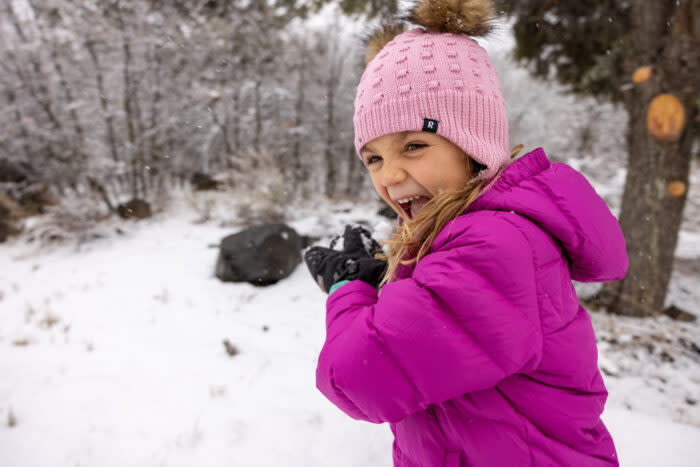
If you know you’re looking for waterproofing, it’s good to know that there are varying levels of water resistance. These are called waterproof ratings, and they are measured in millimeters. During this testing process, a one-inch by one-inch cylinder is placed over the tested fabric. The cylinder is then filled with water. The height that water reaches before the fabric leaks — known as the water column — is where the waterproof rating comes from.
0-5,000mm: Minimal to no water resistance.
6,000-10,000mm: Rainproof and waterproof under light pressure.
11,000-15,000mm: Rainproof and waterproof unless under high pressure.
16,000-20,000mm: Rainproof and waterproof under high pressure.
20,0000mm+: Rainproof and waterproof under very high pressure.
For most external kids’ snow gear, you’ll want waterproof ratings that minimally fall between 6,000-10,000 mm.
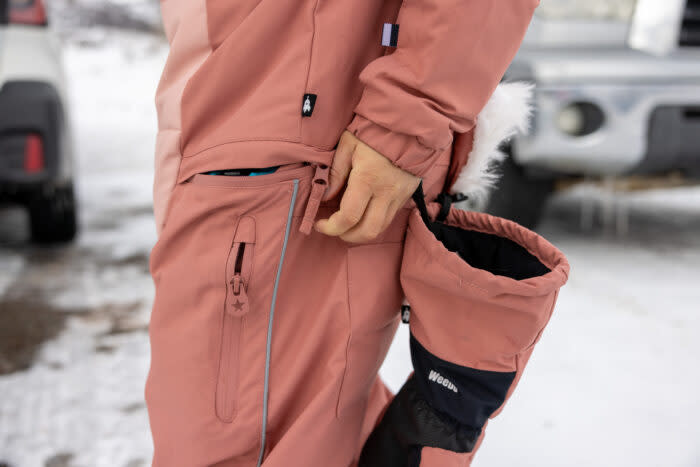
It’s also a good idea to understand where waterproofing comes from as most fabrics aren’t naturally waterproof. To get this waterproofing, most apparel uses either a laminate or a coating. A laminate is similar to wallpaper in that it provides full coverage with the best level of waterproofing. It costs more and is frequently made from polyurethane (PU). Unlike wallpaper, a coating is painted on in a similar fashion to how we paint a wall. While this is more affordable, it doesn’t offer as effective waterproofing.
Most outerwear uses Durable Water Repellent, or DWR. This is an added chemical finish that allows the moisture to bead up on the surface of the garment. Historically, DWR was a toxic concoction packed with “forever chemicals” called polyfluoroalkyl substances, or PFAs. These days, many brands like REI and Patagonia are taking a stand against these toxic chemicals and using PFA-free DWR that is better for the environment.
Final note: while most outdoor brands would disagree, there really isn’t such a thing as “waterproof-breathable” fabric. The more waterproof a fabric, the less breathable it will be; that’s the inherent tradeoff. Materials like rubber are 100% waterproof, but we don’t often wear them skiing because we would overheat immediately. That’s why most kids’ snow gear uses “waterproof-breathable” materials like GORE-TEX. They breathe better than impermeable materials like rubber, but still offer decent waterproofing.
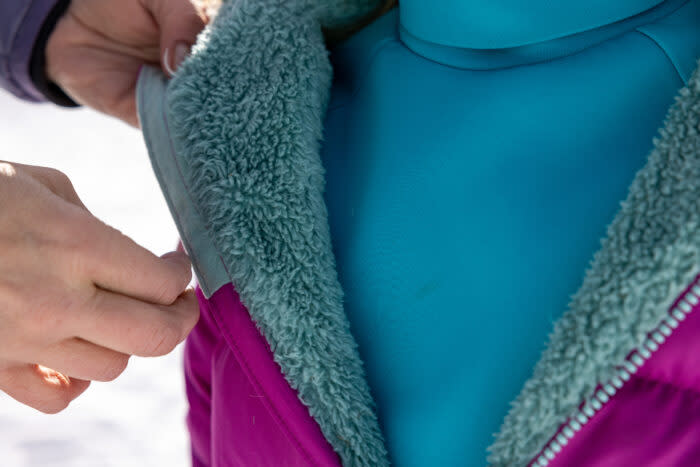
Insulation
Insulation is the ingredient that keeps you warm, but it comes in a variety of forms and fibers.
Down
Down insulation comes from ducks or geese, but it’s not the feathers. Instead, it comes from the plumage, that soft and fuzzy layer that sits beneath. This plumage lofts up inside the garment and traps heat in the air space between all of the fuzzy stuff.
Found in items like the Patagonia Baby Down Sweater Vest or the Patagonia High-Loft Down Sweater Bunting, down is often considered the gold standard since it provides the highest amount of warmth with the lowest amount of weight. But it’s not without its drawbacks. Down doesn’t dry quickly so when it gets weight, it loses its loft and thus, its warmth. It also costs more than synthetic insulation.
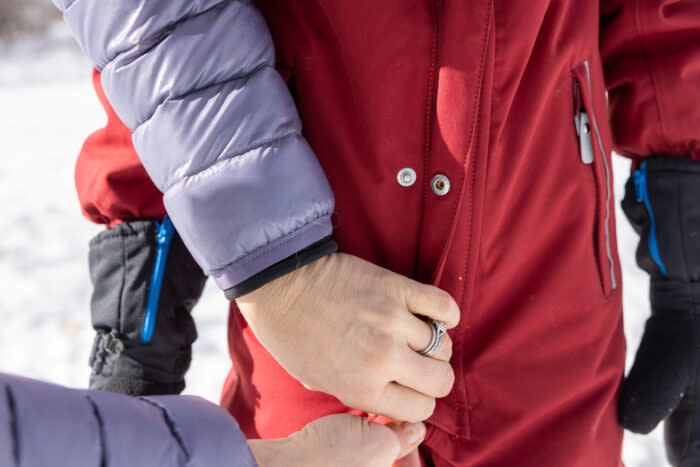
Synthetic Insulation
Synthetic insulation goes by a number of names since many brands make their own proprietary version. In general, synthetic insulation uses some type of man-made, compressible fibers to warm us up. Unlike down, these are water resistant which makes synthetic insulation a better choice in wet environments. Synthetic insulation is often heavier and less packable than down, but it often costs less money. It can be found in a ton of kids’ ski and snowboard clothing like the Patagonia Everyday Ready Jacket, the Patagonia Baby Reversible Tribbles Hoody, or the Reima Stavanger snowsuit. It’s also the common choice for mittens and gloves like the Gordini Easy-On Mittens.
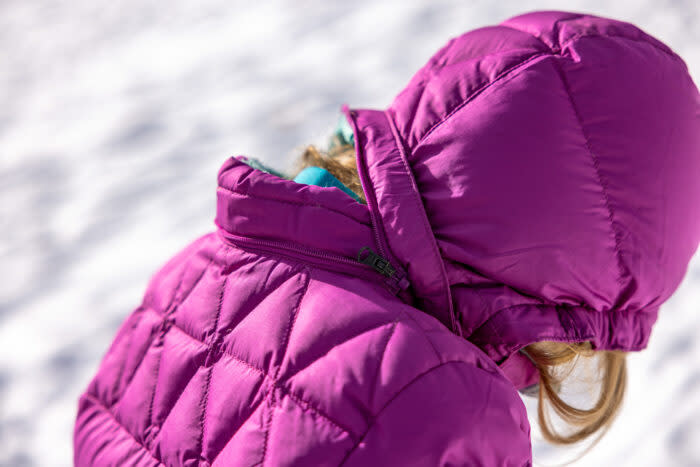
Alternative Insulation
While down and synthetic insulation are the most popular forms of insulation, there are many other alternate options for fibers that keep us warm. For example, the Columbia Sportswear Powder Turner Omni-Heat Infinity Insulated Snowpants, Columbia Sportswear Omni-Heat Midweight Baselayer Crew and Tights, and the Columbia Sportswear Cloudcap Fleece Gloves both use the brand’s proprietary thermal reflectivity, a series of silver dots inside the clothing that reflect your body heat back at you to maintain warmth.
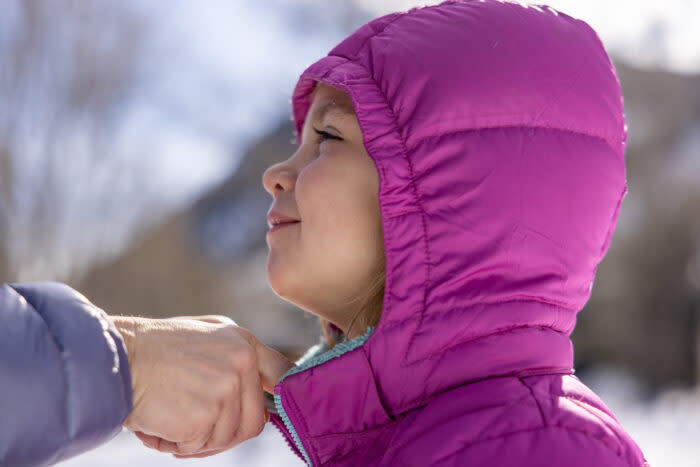
Windproofness
Windproofing may not immediately be something you consider when buying kids’ snow gear, but it’s an important factor. If an item has low windproofing, wind can rip through the warmth.
In general, kids’ ski and snowboard clothing will fall into one of two categories: windproof or wind-resistant. Any item that is waterproof will also be fully windproof since the barrier blocking the rain and snow is also blocking the wind. Simultaneously, a water-resistant item will also be wind-resistant.
The tradeoff with wind-resistant items is that they are more breathable than windproof gear, making them great choices for high-output activities like cross-country skiing. That’s why the Hestra Junior Tracker Gloves are only wind-resistant; they are very breathable for Nordic skiing.
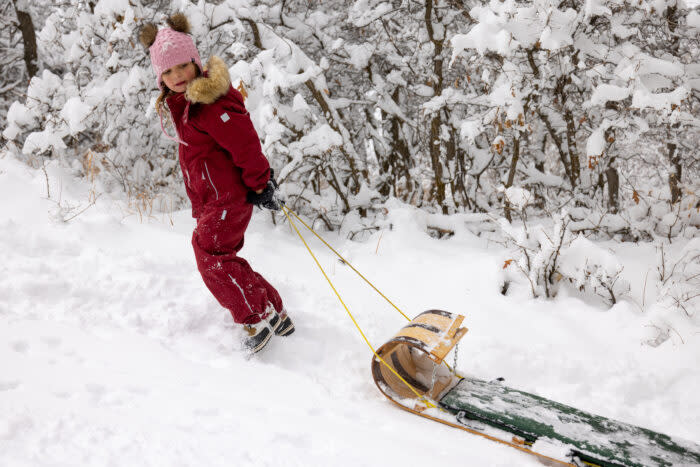
Breathability
As we mentioned before, breathability is the game changer when it comes to water or windproofing. While it’s great to be dry and safe from the snow and rain, no one wants to go skiing inside a portable sauna. That’s where breathability comes in.
In science terms, breathability is the transfer of water vapor from the inside of the fabric to the outside. This happens because opposites attract: Your warm, sweaty body heat is drawn to the cold and fresh outside air. The more efficient this process is, the better you feel without getting cold or clammy. However, breathability is much easier when there isn’t a waterproof or windproof barrier blocking the path of the vapor transfer.
That’s why non-waterproof items like the Chasing Windmills Merino Sweatshirt and Sweatpants or the Columbia Sportswear Rugged Ridge Half-Zip Sherpa Pullover are so breathable; they don’t have any type of waterproofing. Snow gear like the WeeDo Ohdeer Deer Snowsuit or the Obermeyer Snoverall Bibs will have less breathability but perform far better against wet and snowy weather.
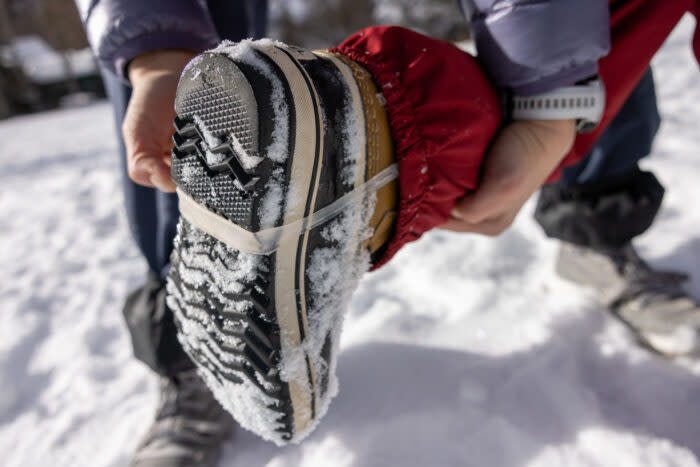
Reinforcements
It’s no secret that children are tough on gear. That’s why kids’ snow gear often has reinforced sections to add durability in high-wear areas. For kiddos, these areas are often the knees, elbows, butt, and hem of snowpants or snowsuits. The fabric of the reinforcement varies but is often a high-denier polyester, Cordura, or ballistic nylon.
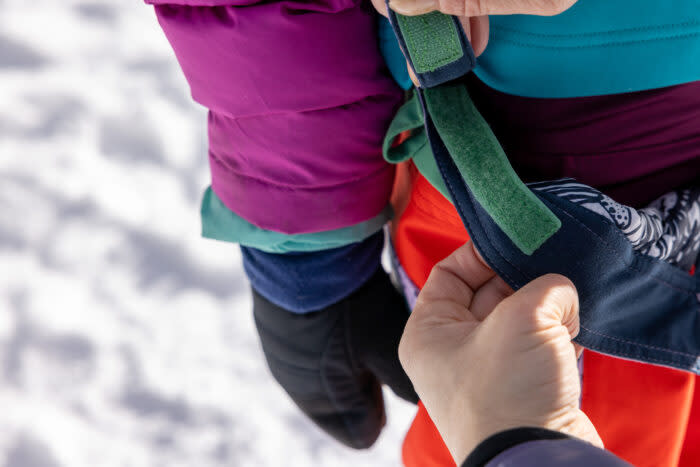
Adjustability and Growth System
Kids grow like weeds, and it’s the parents who have to shell out cash every year to buy the next size. That’s why adjustability and growth systems are a key element to most kids’ snow gear. Brands like Columbia Sportswear, Obermeyer, and WeeDo all have similar systems that allow parents to remove some stitching or undo a snap to release 1-2 inches of added length in the arms or legs. This allows kids to wear items longer and get more use out of them.
Other brands like Reima intentionally make a roomy product so that it lasts longer. If your child wears a size 4T in the Reima Stavanger, he will likely find it big at first. This is intentional because Reima wants the snowsuit to last for more than one season.
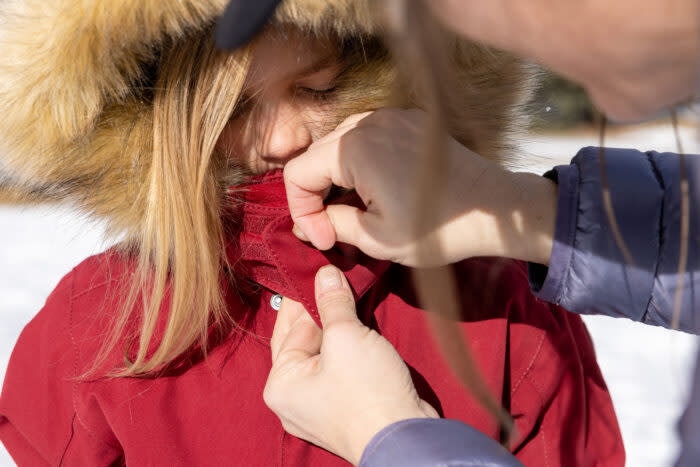
Hood and Collar
The vast majority of kids’ snow jackets have some type of hood. That’s because we lose the majority of our heat through our heads, and a hood is a great way to keep your kiddo warm.
However, there are various types of hoods depending on how you plan to use the jacket. A fixed hood is one that is permanently attached while a removable hood (like the L.L.Bean Kids’ Down Jacket) is one that is attached via a zipper or snaps. This means your child can take it off during a warm day or if they are wearing a beanie and don’t need it. Hoods can also be lined, unlined, or insulated.
Insulated hoods are warmer and are best for sedentary activities in cold weather. A lined hood has a second layer of fabric sewn into the interior which adds a little more warmth but is mainly a nicer aesthetic.
Kids’ snow gear doesn’t have as many collar options as adults, but you’ll still see options varying from unlined to fleece-lined. When possible, opt for a fleece-lined collar since that warm coziness goes a long way toward keeping your child comfortable.
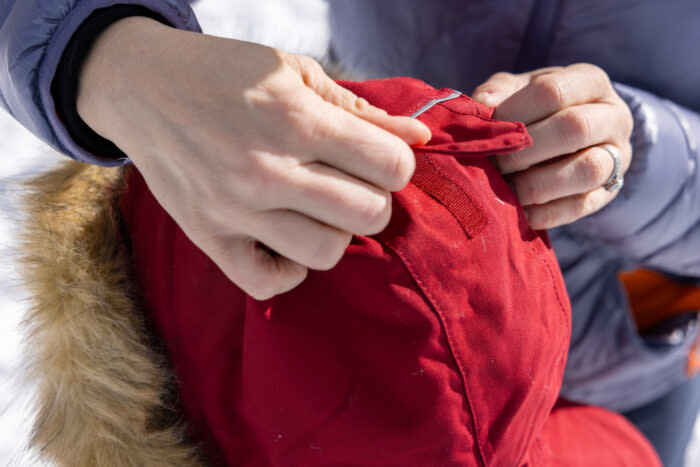
Pockets
Pockets are equally important for adult ski jackets and kids’ winter jackets, but zippered pockets are especially crucial for our littlest rippers. At a minimum, look for kids’ gear and apparel that has at least two zippered hand pockets for children to use for warmth or to stash away secret treasures.
Snow pants like the Namuk Crusade Snow Pants Upcycled go above and beyond by adding Velcro cargo pockets on the side of the leg. Butt pockets are less essential for kids — especially toddlers — since they spend so much time sitting on their rears.
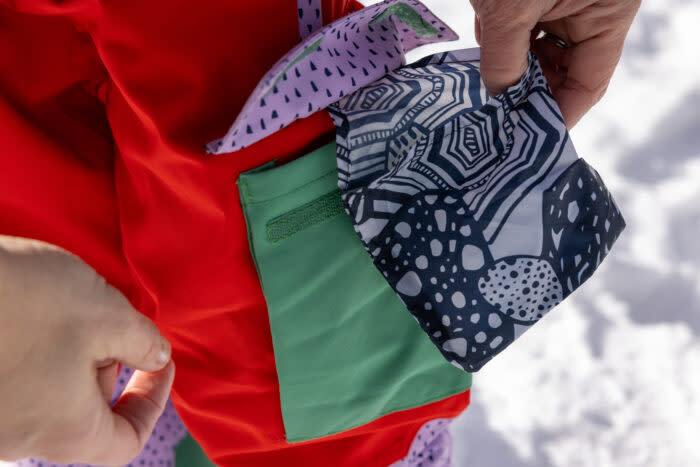
Sustainability
Gone are the days when we don’t pay attention to the fibers our children are wearing. When possible, opt for natural fibers like the Merino wool found in the Iksplor Kid Iksplorer Set. While they are more expensive than synthetic options, natural fibers are not derived from the fossil fuel industry and degrade at the end of their life cycle.
If you can’t swing the cost of natural fibers or it doesn’t make sense (like with waterproof outer layers), try to choose kids’ ski clothes made from recycled materials like those found in the Patagonia Kids Capilene Midweight Crew and Bottoms. While these still struggle with degradation at the end of their life cycle, they are less reliant on fossil fuels since we are only dealing with a single extraction.
For insulation, it’s also a good idea to make sure your down is Responsible Down Standard (RDS) or Global Traceable Down Standard (GTDS) certified. This means that the plumage is coming from a reputable source with high standards for animal welfare and a transparent production process.
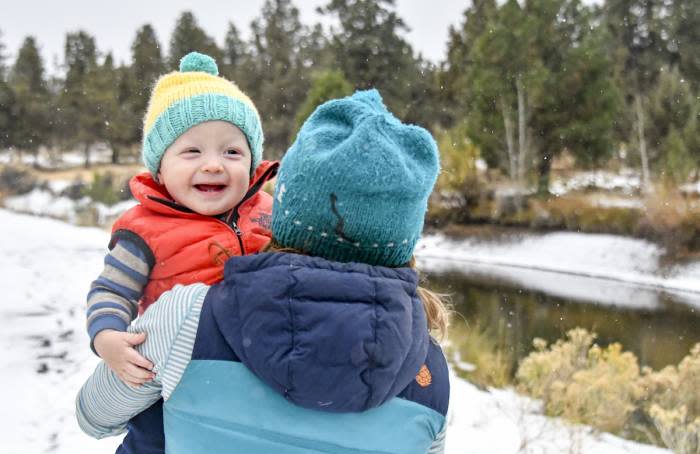
Price
Kids’ snow gear runs the spectrum when it comes to pricing; some items simply cost a lot more than others. An expensive item doesn’t necessarily mean it is better than an affordable alternative. However, sustainable fibers and eco-friendly companies do come at a cost; you’ll pay more so the planet pays less.
Lowest Price: $20-60
Mittens for kids will be one of the more affordable items you buy and will typically range from $20-$60. The Columbia Cloudcap Fleece Gloves at $25 are on the affordable end of the spectrum since they offer a lot of warmth but no weather resistance.
Moving in the other direction, the Gordini Easy-On Mittens ($30) are more expensive but offer higher warmth and all-around weatherproofing. The Hestra Junior Tracker Gloves ($50) are the priciest in this buyer’s guide. While they aren’t waterproof (by design), they do have high-quality craftsmanship and premium materials that add to the cost.
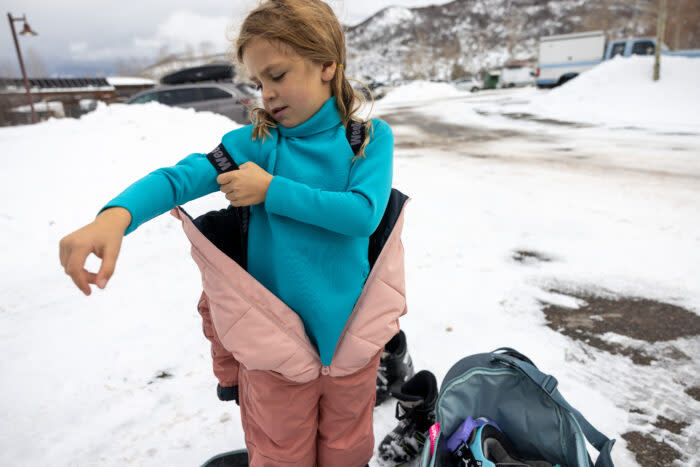
Base layers are a necessity for your children and you can expect to pay anywhere from $30 to $60 per item. The Columbia Omni-Heat Midweight Baselayer Crew ($25) is the most affordable in our grouping, because it’s made of synthetic materials with less of an emphasis on sustainability.
The Patagonia Kids Capilene Midweight Crew ($39) is priced in the middle of the spectrum. While it still uses synthetic materials, they are all recycled and that adds to the cost. At $109 per set ($55 per item), the Iksplor Kid Iksplorer Set is the priciest of the base layers, but you’re getting 100% merino wool that is certified by the Responsible Wool Standard.

Moderate Price: $60-120
Midlayers look very different from kid to kid and brand to brand, and the cost is commensurate ranging from $50 to $120. On the more affordable end are the Columbia Rugged Ridge Half-Zip Sherpa Pullover and the Chasing Windmills Merino Fleece Sweatshirt, each at $60. The Rugged Ridge is fully synthetic but offers more warmth while the Chasing Windmills is made from sustainable materials.
The Patagonia Baby Down Sweater Vest falls somewhere in the middle ($99) thanks to a host of sustainable materials like recycled polyester and recycled down. The L.L.Bean Kids’ Down Jacket ($109) sits at the top of the spectrum, because it offers more warmth and weather resistance than any of the other midlayers.
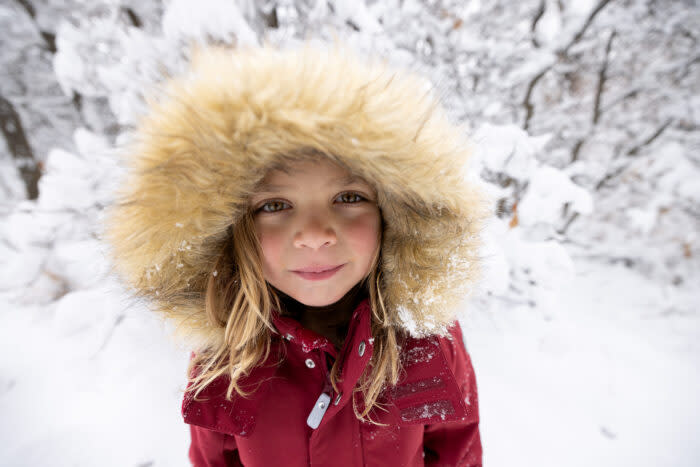
Higher Price: $120-300
Outer layers like snow pants, ski jackets, and snowsuits will be the most expensive item you buy since they offer warmth and all-around weather protection. For ski jackets and snow pants, the price range is vast: $80-250. The Oaki Rain/Trail Suit ($69) is the most affordable outer layer in our guide. While it offers complete waterproofing, it does not have any insulation.
The Columbia Powder Turner Suspender Ski Pants ($90) and the Obermeyer Snoverall Bibs ($100) are next on the list. Like the Oaki, they both offer solid waterproofing but these also have a decent amount of insulation to keep kids warm, too. The Patagonia Baby Reversible Tribbles Hoody is at a similar price point ($109). While it also has waterproofing and insulation, you’ll also get a host of recycled materials.

The Patagonia Everyday Ready Jacket ($159), the Patagonia Infant High-Loft Down Sweater Bunting ($169), and the Namuk Crusade Snow Pants Upcycled ($149) are all near the top of the pack in regard to budget. While each of these products is completely waterproof and fully insulated, they’re also constructed by brands with an ethos rooted in sustainability — and the materials show that.
Finally, the Reima Stavanger Snowsuit ($195) and the WeeDo Ohdeer Deer Snowsuit ($282) sit on the highest end of the spectrum. Both of these are full snowsuits, so you’re getting both a jacket and snow pants with waterproofing and tons of insulation. Beyond that, you’re also getting a lot of attention to detail with kid-specific features that no other brand has. If you and your child spend a lot of time outside, the added cost may be worth it.
FAQ
What is the best brand for kids’ snow gear?
There isn’t a single brand that is categorized as the “best” brands for kids’ ski clothing.
However, there are certainly brands that make high-quality products for kids. In the United States, Patagonia has long been known for exceptional kids’ apparel, with a special nod to their Infant High-Loft Down Sweater Bunting. Columbia Sportswear is also known for decent and affordable kids’ snow gear. But in the past 5-7 years, more new or European brands have come to the American market with kids-only apparel, adding more competition and quality into the category. These brands include Iksplor, Reima, WeeDo, and Namuk, to name a few.
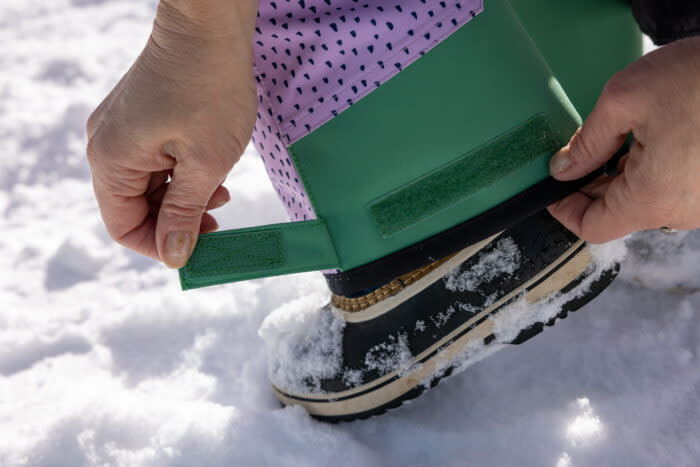
What is the best brand for kids’ snow gear?
There isn’t a single brand that is categorized as the “best” brands for kids’ ski clothing.
However, there are certainly brands that make high-quality products for kids. In the United States, Patagonia has long been known for exceptional kids’ apparel, with a special nod to their Infant High-Loft Down Sweater Bunting. Columbia Sportswear is also known for decent and affordable kids’ snow gear.
But in the past 5-7 years, more new or European brands have come to the American market with kids-only apparel, adding more competition and quality into the category. These brands include Iksplor, Reima, WeeDo, and Namuk, to name a few.
Which is better: Snow pants or a snowsuit?
Neither is better and there is no overall rule on snow pants versus snowsuits. However, a general rule of thumb is that snowsuits are better for smaller kiddos (younger than kindergarten) whereas snow pants are more popular with the older crowd. Snowsuits work best for babies, toddlers, and preschoolers because there are no cracks to let cold air or snow inside.
As a result, they tend to be warmer which is especially helpful for babies who cannot communicate their needs. However, they are more cumbersome, particularly for kids who are not wearing diapers. That’s why most older children start to rebel against them and ask for snow pants.
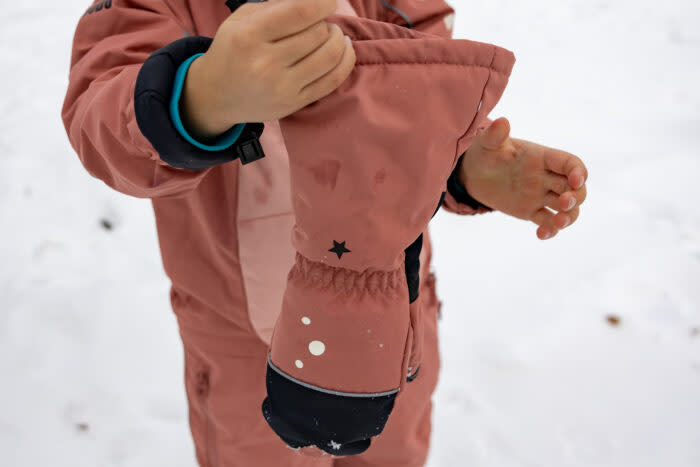
How do I know how warm my baby is while outside?
Gauging your baby’s warmth during outdoor adventures is one of the most stressful parenting tasks. It’s so relative: Some babes run warm and others are little ice cubes.
If you’re worried about them while playing in the snow, check on their temperature by feeling their core every once in awhile. If it feels cold to the touch, put another layer on them. If it’s too hot, remove a layer.
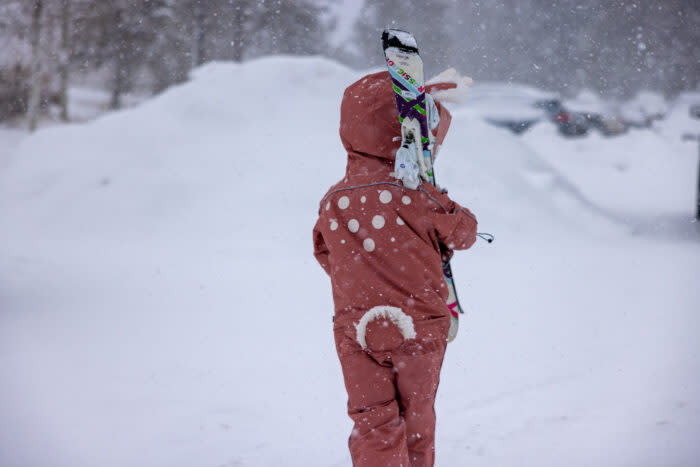
Which pieces of gear should we emphasize first?
It is often overwhelming to build out your child’s first winter kit, so start with the basics. First, prioritize high-quality baselayers. These are the items that will sit next to your child’s skin and can make or break their comfort. Second, emphasize the outer layers (which may or may not include insulation).
Children have a tendency to wallow in the snow far more than adults do, so it’s more important to guarantee waterproofness and a reliable layer against Mother Nature. Lastly, consider their appendages. Hands and toes are typically the first things to get cold, so pay extra attention to their hand coverings. For the most part, ditch the gloves; mittens are much warmer for little fingers.
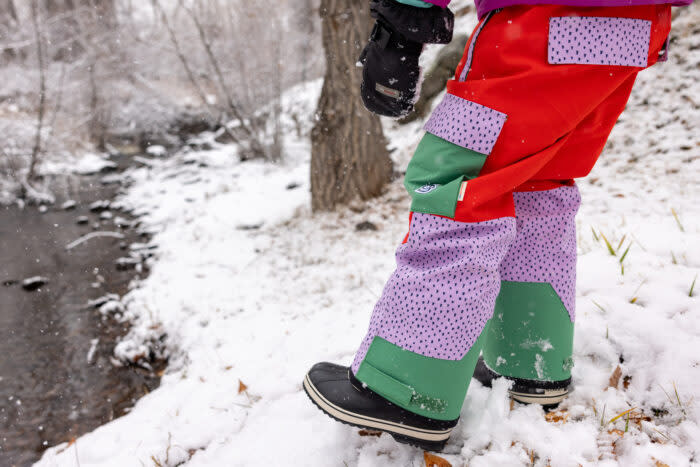
Where can I find affordable used gear?
If parents made all of the kids’ outdoor clothing, it would probably be more affordable. But as it is, kids’ clothes can be outrageously expensive. On the one hand, we want our babies to be comfortable on outside adventures. On the other hand, we still need a few bucks left in the bank for said winter adventure.
We’ve found a few strategies for gearing up for winter without breaking the bank. First, before you drop a ton of money on winter gear for your child, check out local thrift or used gear stores.
Ask your fellow parent friends if they have anything they don’t need anymore. Having a go-to source for secondhand gear can be a real treasure.
Next, prioritize and think about how often you’ll really use something. If it’s something you know you’ll use quite often, it’s worth the splurge. But if it’s a once-per-year kind of item, consider finding an affordable alternative.
Most of all, just get out there. Whatever gear you end up choosing, your kid, your sanity, and your family memories will thank you for making the effort to get outside—even when the temperature drops and the snow flies.
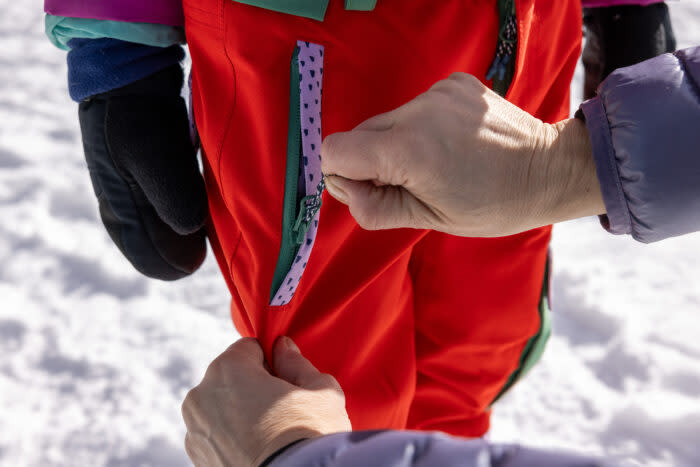
Waterproof Down Warmth, Fleece-Lined Comfort: Kids’ L.L.Bean Down Jacket Review
L.L.Bean’s Down Jacket is our daughter’s daily driver for its cozy warmth and lightweight design that doesn’t weigh her down.
I’ve Camped 1,000 Nights With My Kids: Here’s What I Learned
Taking the family on camping trips doesn’t have to be complicated or stressful. Here are a few tips from a professional athlete on how to…
The post The Best Kids’ Snow Gear of 2024 appeared first on GearJunkie.

